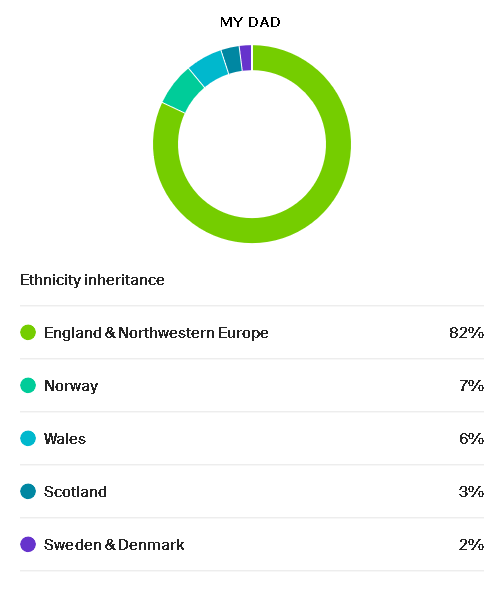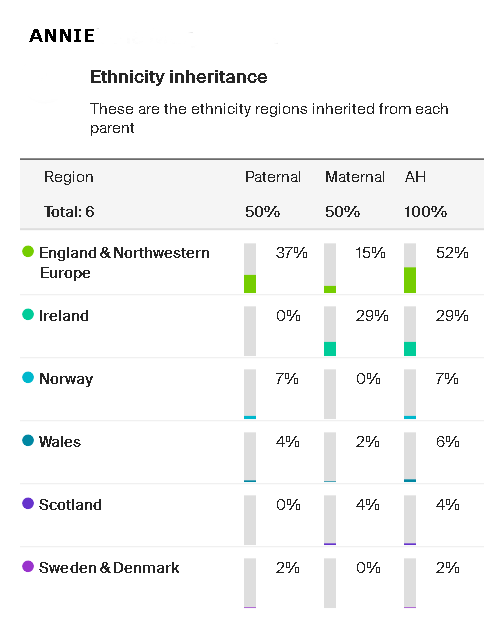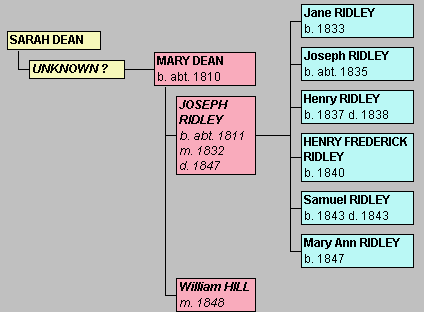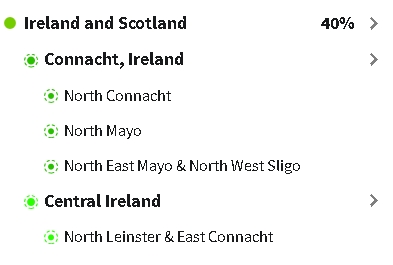DNA goes some way towards uncovering the truth
Category: DNA
I have access to a number of DNA kits belonging to people who descend from James Geake but I've not been able to find any useful DNA matches on either the Geake or the Dearing side. Most of these relatives have a lot of Irish and Scottish ethnicity in their DNA which I suspect is on James' line and this doesn't fit at all with James supposedly having ancestors from Devon.
Here are the Irish and Scottish AncestryDNA ethnicity estimates for my relatives.
My mum - Ireland: 30%, Scotland: 20%.
My aunt - Ireland: 28%, Scotland: 21%.
My mum's 1st cousin No.1 - Ireland: 38%, Scotland: 12%.
My mum's 1st cousin No.2 - Ireland: 30%, Scotland: 65% (we are related to this person on her father's side but her mother was from Scotland so this would explain the higher Scottish ethnicity).
My mum's 1st cousin once removed No.1 - Ireland: 23%, Scotland: 16%.
My mum's 1st cousin once removed No.2 - Ireland: 18%, Scotland: 15%.
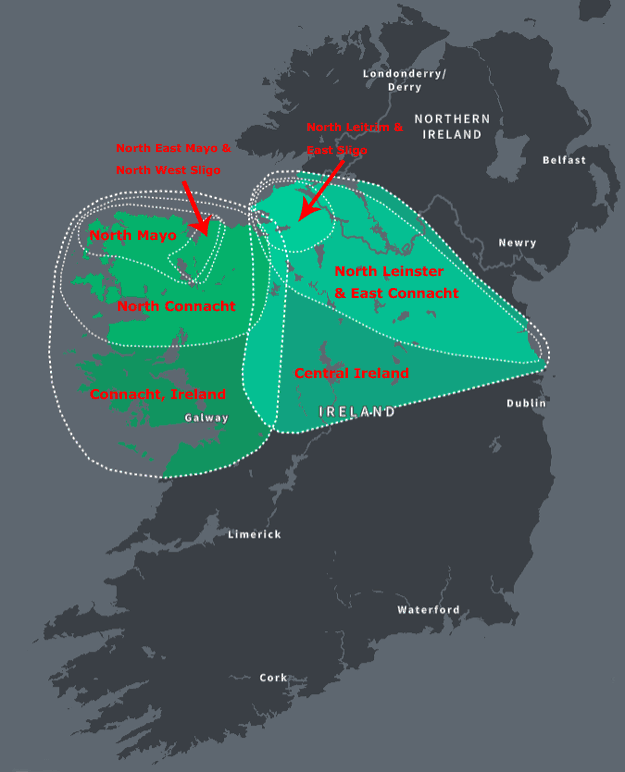
AncestryDNA Genetic Communities for the descendants of James Geake
The map shows the Irish DNA genetic communities at Ancestry which are specific to some of these relatives. Mum's 1st cousin No.1 has all of these regions. My aunt has all but the small region of North Leitrim & East Sligo. My mum shows North Connacht and the region of North East Mayo & North West Sligo but not North Mayo and no Central Ireland. Mum's 1st cousin No.2 just has North East Mayo & North West Sligo but no other Irish regions. The two 1st cousins once removed don't have specific Irish genetic communities but my mum passed the North East Mayo & North West Sligo region on to me. This demonstrates a strong connection to these areas amongst the four of James Geake's grandchildren who have tested. There surely has to be something in this!
It's worth noting that my mum and aunt do in fact have Devon genetic communities as does one of the 1st cousins once removed. This can be explained by the fact that James Geake's wife had Devon ancestry so Devon ancestors will be common to all of the above mentioned relatives. James Geake and his wife, Sarah May Hellyer, were my mum's paternal grandparents but there were North Devon ancestors on my mum's maternal grandmother's side too.
All these ethnicity estimates and the lack of the expected DNA connections was pointing in the direction of James Geake not being George Geake and Maria Dearing's son. Now I wanted to find some further evidence to substantiate my theory.
James Geake had an older sister called Maria Geake who married Henry Albert Carpenter. My mum knew her as her Great-aunt Maria (pronounced Mariah as in Mariah Carey). Mum has always known Maria's grand-daughter who I'll call Emily to protect her identity. Emily kindly agreed to take a DNA test and the results came back showing no match to any of the descendants of James Geake. Emily should have been my mum's 2nd cousin and all 2nd cousins should share DNA. Even half 2nd cousins would be expected to share DNA but there is no match to any of Emily's four supposed 2nd cousins.
Emily has DNA connections on the Geake and Dearing lines so this indicates that James was the odd one out. In addition, she only has 6% Irish ethnicity and no Scottish ethnicity. Therefore, my long-held suspicion that James Geake was not the son of his documented parents seems to be correct.
I would add that there are one or two distant DNA matches that we have in common with Emily which I think are likely to be co-incidences. Emily has a lot of Devon ancestry and, as previously stated, so do we. Autosomal DNA can't tell you which family line you are looking at when you see a match so a lot of time is spent studying family trees to find ancestors in common with your DNA matches. There's a good chance that our DNA might match with descendants of Devon ancestors which also match with Emily but on different branches of our families. At first glance, they look like Geake and Dearing connections but we now know this is unlikely unless we have a more distant connection to these families back in time.
It's disappointing to discover that we're not biologically related to Emily and her family but, nonetheless, her ancestors are still part of my own family's story as James was brought up in the Geake household as one of their own. In my mind that makes Emily's ancestors my 'adoptive' family and there are still descendants of James who bear the Geake name to this day.
One final anecdote - a relative once told my mum that James Geake used to celebrate his birthday on the 23rd January but, much later in life, he obtained a copy of his birth certificate. This was when he discovered he was actually born on the 25th. It makes me wonder if he really was born on the 23rd before being handed to the Geakes a couple of days later. What's more, did James ever know they weren't his biological parents?
Please feel free to follow my Blog on Facebook
[Note: All content on the Hibbitt & Barnes Family History website and blog is copyrighted. Click here for conditions of use.]


